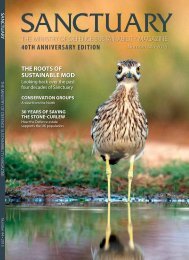SUSTAINABILITY
UBUt5
UBUt5
You also want an ePaper? Increase the reach of your titles
YUMPU automatically turns print PDFs into web optimized ePapers that Google loves.
AROUND THE REGIONS<br />
24<br />
North Yorkshire<br />
Ripon Parks and Ellington Banks<br />
Elevator nets at Ripon Parks © East Dale Ringing Group<br />
Ripon Training Area is comprised of<br />
three main sites clustered within 2km<br />
of one another on the northern fringe<br />
of the historic city of Ripon, nestled in<br />
between the Yorkshire Dales and North<br />
Yorks Moors. The training area supports<br />
a variety of military use, including driver<br />
training, bridging, heavy engineering<br />
and infantry training, and also supports<br />
a range of diverse and valuable wildlife<br />
habitats. Two of the training sites, Ripon<br />
Parks and Ellington Banks, have national<br />
and local nature conservation<br />
designations and are subject to various<br />
types of management and monitoring<br />
throughout the year.<br />
Ripon Parks consists of 275ha of neutral<br />
and calcareous grassland, wetland and<br />
woodland on the banks of the River<br />
Ure, much of which is designated as<br />
part of two Sites of Special Scientific<br />
Interest (SSSI) due to the important<br />
diversity of habitats and geological<br />
features. Most of the area is managed<br />
by sheep grazing, but one of the main<br />
diffculties in maintaining the SSSI<br />
habitat in favourable condition, like<br />
many other riparian sites in the UK, is<br />
the presence of the highly invasive<br />
non-native plant Himalayan balsam.<br />
This alien species is extremely adept at<br />
rapidly colonising damp soils at the<br />
expense of more diverse and beneficial<br />
native plants. In summer 2014, as in<br />
previous years, Landmarc Support<br />
Services put considerable effort into<br />
controlling the growth of balsam<br />
before it could set seed. This is a<br />
laborious task requiring pulling by<br />
hand, a task with which many MOD<br />
sites and conservation groups are<br />
unfortunately all too familiar with, and<br />
although we continue to endeavour to<br />
set a good example of responsible land<br />
management by controlling it within<br />
our own boundaries, it will take a<br />
concerted effort by other landowners<br />
throughout the river catchment to<br />
achieve a long term improvement.<br />
During the winter months volunteers<br />
from the East Dales Ringing Group led<br />
by Jill Warwick gave up their time to<br />
clear rushes from part of the SSSI and<br />
manage adjacent willows. This is done<br />
on rotation to maintain scrub that aids<br />
the bird monitoring they have been<br />
undertaking for the past 12 years, and<br />
adds to overall structural diversity. Their<br />
ringing efforts were rewarded with an<br />
exceptional sample of migratory winter<br />
thrushes thanks to the use of their<br />
innovative ‘elevator nets’, most notably<br />
redwing which totalled more than 400.<br />
Nearby at Ellington Banks the<br />
monitoring focus has been on<br />
invertebrates, and Dr Charlie Fletcher is<br />
keen to discover more about the life<br />
cycle of Scrobipalpa pauperella, a small<br />
inconspicuous moth that was thought<br />
extinct in the UK for 40 years until<br />
Charlie confirmed its presence on site,<br />
along with 650 other moth species he<br />
has recorded there. The plan for 2015 is<br />
to broaden our knowledge by<br />
confirming the larval food plant used<br />
by S. pauperella so we await Charlie’s<br />
results with interest, and in the mean<br />
time have been concentrating on<br />
maintaining the value of the magnesian<br />
limestone grassland and wetland areas<br />
where the moth was found.<br />
Ellington Banks is 65ha in size and<br />
notified as a Site of Importance for<br />
Nature Conser vation by Harrogate<br />
Borough Council. Thanks to an offer of<br />
help from the Nidderdale AONB<br />
Conservation Volunteers, three winter<br />
volunteer days were organised which<br />
focused on clearing invasive scrub from<br />
the limestone grassland and ponds.<br />
These are important features on the<br />
site in terms of botanical value,<br />
invertebrates and breeding amphibians<br />
including great crested newts. The<br />
group were able to field an enthusiastic<br />
team of up to 15 volunteers per session<br />
led by the AONB Volunteer Coordinator<br />
Paul Mosley and supported by DIO, and<br />
their efforts in clearing half a hectare of<br />
alder and willow were greatly<br />
appreciated. This was communicated<br />
directly to the volunteers by a visit from<br />
the training area’s Training Safety<br />
Offcer Major (Retd) Paddy Ennis when<br />
he thanked them for their contributions<br />
and gave a short talk on the history and<br />
use of the site. In times of austerity<br />
when budgets are stretched support<br />
from local volunteers to help maintain<br />
the conservation value of the training<br />
estate is becoming more important as<br />
a means of maintaining effective<br />
delivery, and we thank all who<br />
contribute by giving up their time to<br />
help manage and monitor our natural<br />
resources on the MOD estate.<br />
John Black<br />
Ecologist<br />
Defence Infrastructure Organisation<br />
Sanctuary 44 • 2015 97



